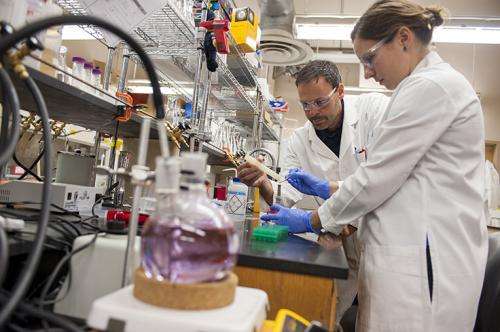MSU team overcomes challenges, proves that microbes swim to hydrogen gas

(Phys.org) —Scientists have long believed that microorganisms that produce methane swim toward the hydrogen gas they need to stay alive, but it has been too hard to prove in the lab.
Montana State University researchers have now overcome those challenges, allowing them to verify it for the first time, said Matthew Fields, an associate professor in MSU's Department of Microbiology and co-author of a new paper describing the find.
In the process, the researchers discovered hydrogenotaxis, the movement of a biological cell toward hydrogen gas, and noticed that the cells were especially speedy when starving. They also made a video of the microorganism rushing toward its next meal. The methane-producing organism lives without oxygen, and it's classified as Archaea, one of the three domains of life.
An article explaining MSU's find is published in the Nov. 5 issue of Scientific Reports, an online journal affiliated with the international journal Nature.
The MSU breakthrough helps fill in gaps of knowledge about microorganisms that are crucial to Earth's carbon cycle, early Earth processes and climate change, Fields said. It will also have implications across a wide range of disciplines since methanogenic Archaea live in anaerobic environments, ranging from salt marshes to wastewater treatment to the human microbiota. Whenever organic matter is being degraded, these microorganisms are typically present.
"They are the bottom of the food chain," Fields said.
MSU microbiologist Gill Geesey, who encouraged the team to pursue the project, added that the scientists demonstrated hydrogenotaxis for the first time in any domain of life. He added that the movement likely gives microorganisms a competitive advantage for accessing hydrogen in the environment.
"Hydrogenotaxis may also promote the establishment and maintenance of microbial interactions at the population- and community-level, which has been a focus of research at the Center for Biofilm Engineering at Montana State University since its establishment in 1990," Geesey said. "The observed hydrogenotaxis could represent an important strategy used by methanogens and other hydrogen-utilizing microbes for cyclingof elements in natural and engineered processes. "
Fields and four collaborators conducted their research in the Center for Biofilm Engineering (CBE), using a common microorganism that converts hydrogen gas into methane. Methanococcus maripaludis is approximately one micron in diameter—one millionth of a meter—and can only be seen under the microscope. It is difficult to grow in a lab, one reason that researchers have been unable to verify earlier that Archaea organisms swim toward hydrogen gas, Fields said.
To conduct their research, the scientists created an oxygen-free environment in a fragile tube. Creating that environment was challenging, another reason that their discovery didn't occur earlier, Fields said.
After varying lengths of time, they released the cells into a solution to encounter hydrogen gas from the opposite end of the tube. That's where they proved what everyone had suspected – that Archaea swim through liquid toward hydrogen gas.
Every step in their experiments had to be done without breaking the tube or introducing oxygen, Fields said. It also had to be done inside an incubator with microscopes and computers. Computer software tracked the cells, proved they responded to hydrogen gas, and determined their speed.
Considering that speed relates to body length, Fields said the microbes moved faster than cheetahs, the fastest land animal on Earth.
Journal information: Scientific Reports
Provided by Montana State University

















